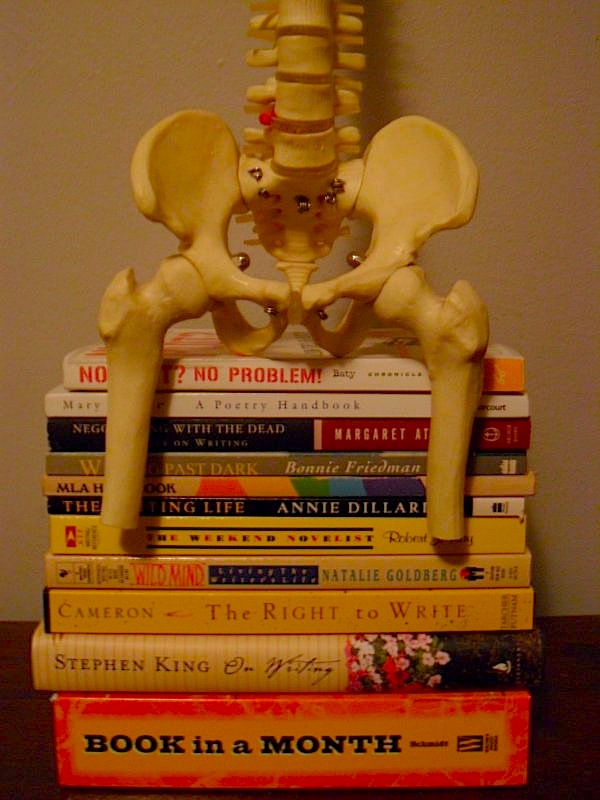
Hello, campers —
No, the doc have no yet cleared me for post-crash keyboarding, one-handed or otherwise — so if any medical type should happen to ask you about it, ix-nay on the log-blay. (And if the first part of that statement seemed cryptic to you, you’ll find an explanation of last week’s festivities here.)
My left hand (i.e., the currently working one) could not resist volunteering to write a glowing intro for this very timely and magnificently useful guest blog by novelist, chiropractor, and Author! Author! community member Annemarie Monahan. After I hurt my back in April, Annemarie very kindly offered to give all of us writers some much-needed tips on how to set up our work spaces (hint: that foot-wide shelf between the oven and the refrigerator is not an adequate writing desk), how and when to take breaks during those long writing sessions (you know, the ones where you snarl at your SO in hour four, “I’ll just be a minute for dinner — I want to finish this paragraph,” and then are astonished when s/he comes back three hours later to inform you that it’s midnight), and generally take much, much better care of our backs than most of us do.
Although Annemarie is here today at Author! Author! wearing her chiropractor and general medical wise woman’s hats, I can’t resist telling you a bit about her women’s fiction work-in-progress, THREE. She describes it as “Think Jeanette Winterson meets Sliding Doors.” As we’ve discussed at such length in the past, it’s genuinely hard to pitch a multiple-protagonist novel well, so I’m delighted to show you her teaser:
Three women. Three strangers. Yet all were the same seventeen-year-old girl on a yellow April morning, wondering, “Do I dare to eat a peach?” Three different answers sent one life in disparate directions. Now, at forty-one, their parallel lines are about to intersect again.
Ántonia searches the sea-horizon every evening. In the last light, she can glimpse it: a feminist Utopia built on an abandoned oil rig, led by her charismatic and bipolar lover. Her lost Eden made by Eves.
For Dr. Katherine North, the memory of two women chafes her like a hair shirt. After the death of one, she contacts the other — only to discover that she has been renounced in the name of God.
Kitty Trevelyan has been happily married twenty-three years. Happily enough. Until her professor asks her for coffee and kisses her.
Piques the interest, doesn’t it? To read more, check out Annemarie’s website.
And now, without further ado — hey, my left hand is new to all of these ks and ls — please join me welcoming Annemarie in her capacity as back care guru. Take it away, Annemarie!



Do you have a shelf of books about writing? I have a stack of them upstairs. So much good advice about the craft, the business… but so little on the physical process and its challenges. Our gracious hostess, Anne, has asked me to talk about writing and our low backs. It’s a subject dear to her… well, spine. Regular readers of this blog will remember that she recently had a bout of low back pain, like nearly half of working Americans any given year, one severe enough that she had to take some time away from amusing and educating us.
Whether we’ve never had low back pain or have a long history, we as writers are particularly susceptible because we sit. And sit, and sit. However, susceptible does not mean doomed. There are simple steps you can take to protect yourself. Let’s talk about a few.
Where do you write? In a home office? In a recliner? At your son’s cast-off kid’s desk? At a cafe? Probably like many of you here, I wrote most of my novel at my kitchen table. Not a bad choice, biomechanically.
Wherever you work, make sure you’re facing your screen or typewriter dead on when you’re relaxed. No twisting. The desk or table should be high enough to allow your chair to be pulled under it while you’re seated, and leave few inches of wriggle room above your thighs.
Now let’s take a closer look at your work space ergonomics. Sit down in your favorite writing position and take a look at your legs.
Do your heels rest on the floor? Or do they dangle in the air? Are you on tip toes? Your feet should reach the ground comfortably and fully. If they don’t, lower your chair or invest in a foot rest.
Next, look farther up. If you drew a line from the front crease of your thigh to your knee, would the line be flat, sloping down, or sloping up? You want either flat or sloping down a little. If the line slopes up, as it does when you sit in a recliner, you’re putting a lot of strain on your low back. Raise your seat (making sure your heels can still rest on the floor!) or add height to it with a firm cushion or support.
Are you writing sitting in bed, or on the couch, feet up? Stop that. Sure, it feels cushy at first, but the softness allows your behind to sink below the level of your knees. Sooner or later you’ll pay for that momentary pleasure as surely as the naïf in the old public health film who keeps questionable company.
Even if we have the perfect work station, our low backs take a beating. How many hours did you put into that first page alone? That first chapter? How many hours are you sitting at your laptop without getting up or even moving?
Writing is a long slog across rough terrain, not a frolic. A marathon, not a sprint.
The human body isn’t designed for marathons. As I say to my patients, look what happened to the guy who ran the first one. But we can strengthen ourselves to achieve feats of endurance, either active or sedentary.
Fortunately, training for the butt-in-chair marathon doesn’t have to take much time or effort. No yoga among the spandexed, no sweaty weight equipment at the Y. Just a few quiet moments at home between paragraphs.
In the over twenty years I’ve been in practice, I’ve learned that no-one– no-one!– will do a long or complicated back exercise program. It’s just not human nature. And it’s always smart to work with human nature rather than against it. With that in mind, please meet…
The Two-Minute Routine to Keep a Happy Low Back*
1. The Hamstring Stretch
Stand up. With one foot firmly supporting you, put the other heel up on the seat of your chair. You shouldn’t feel any pulling in the back of your leg at this point. If you do, use something lower and sturdy. Now rest both your hands on the knee of the leg you have up.
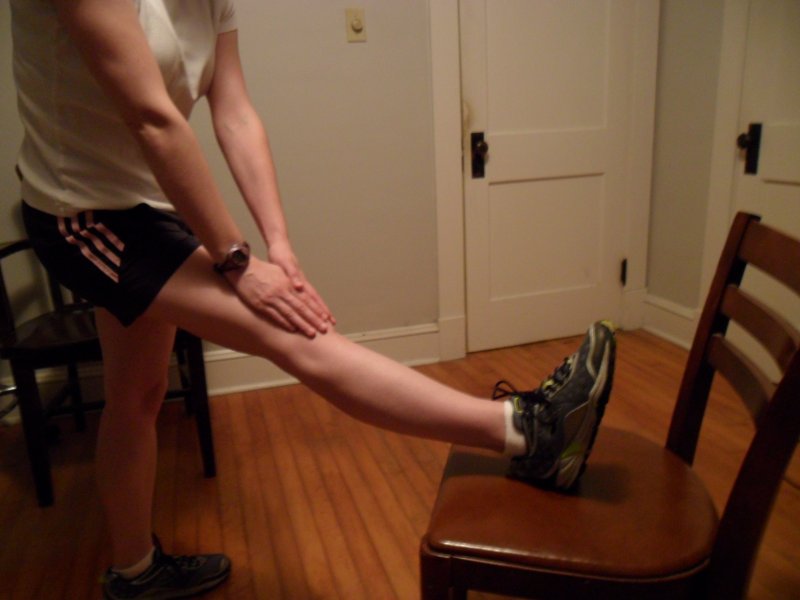
Keep your knee completely straight — bending it ruins this stretch. Don’t worry about where your foot points: just relax. Lean over, nose towards those toes.
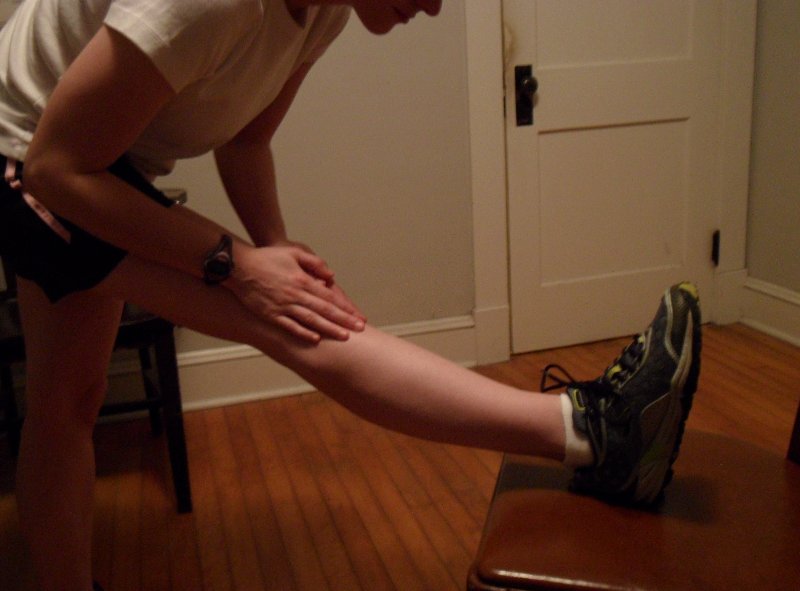
You’ll feel a stretch in the back of your thigh, near the knee. Don’t bounce, don’t yank. Right, in the days before the glaciers retreated, your gym teacher taught you to bounce when you stretch. Mine, too.
But don’t do it. It’s a great way to pull a muscle. Just lean gently and firmly. If there’s pain, back off.
Breathe. Count to ten leisurely.
Come out of the stretch gradually. Repeat for the other side. Don’t be surprised if one side is tighter than the other; that’s normal.
2. The Piriformis Stretch
Next, find a spot where you can lie down comfortably. On a pad or carpeted floor is fine, as is a firm bed if you have a hard time getting up and down.
Lie on your back with one leg bent at the knee, and one flat.
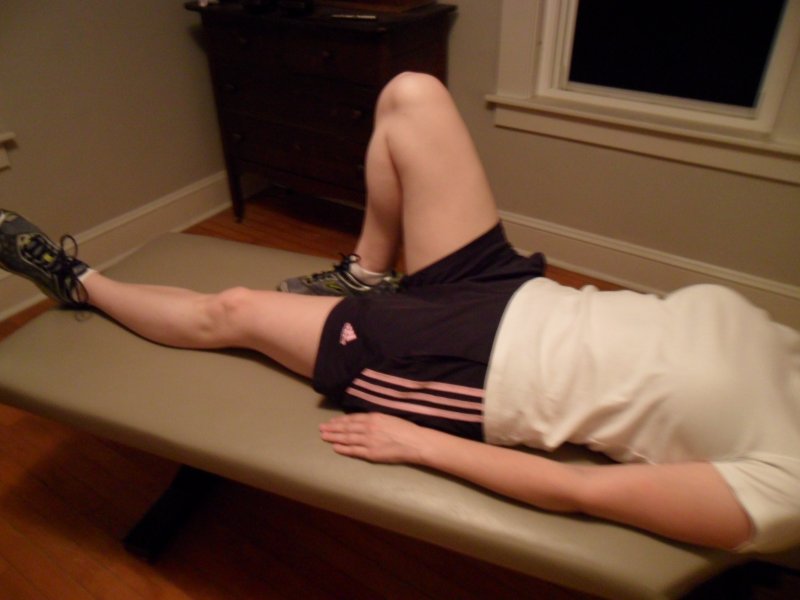
Now, grab that bent knee with both hands. Pull it up and across your body, towards your opposite shoulder. Right, not straight up. Towards the opposite shoulder.
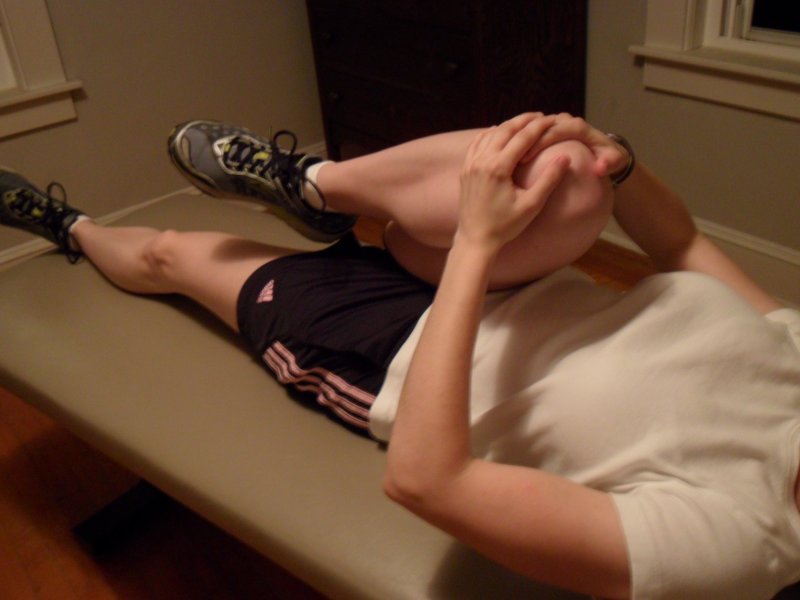
You’ll feel a deep stretch in the side of your behind. Pull gently but firmly, backing off if you experience pain other than that hurts-so-good feeling. Now, read your manuscript aloud in its entirety…
No, wait. Sorry. Breathe! Count to ten.
Again, come out of it gradually and repeat for the other side.
3. The Abdominal Crunch
I heard you whimper. Don’t fuss, these are not the sit-ups you dreaded as a kid.
Stay on your back after the piriformis stretches. Put both your feet on the floor, knees up. Cross your arms over your chest.

Take a breath. As you exhale, come up only about 30 degrees, enough to get your shoulder blades off the floor.

There should be no pain in your low back or neck, only the sensation of muscles working in your belly. Hold for just one beat, then lie down again. Don’t flop. Repeat, making sure to breathe, breathe, breathe!
There’s no ideal number of these crunches, but I tell patients to do as many as they can comfortably, plus one. Always use good form; it’s better to do fewer than to use sloppy technique. This exercise should never hurt.
Don’t worry if you tire quickly. I have patients that can’t do a single crunch. If you can’t either, instead just flatten your low back against the floor by tightening your belly muscles.
Unlike writing your novel, this is process, not goal. You’ll get stronger bit by bit, page by page.
That’s it. It may not seem like much, but with daily small effort, your low back will stay strong and flexible as a well-bound book.
Here’s to your health and writing success!
*I’m sure my attorney would want me to mention this, so here goes: the information provided in this post, such as text and images, is for informational purposes only. It is not to be construed as medical care or medical advice and is not a replacement for medical care given by physicians or trained medical personnel.
Annemarie Monahan is still able to read the Latin of her diploma from Bryn Mawr College, a skill as practical as her degree in English. Belatedly realizing she had to eat, she earned her professional doctorate from Northwestern College of Chiropractic.
Dr. Monahan has been in private practice for twenty-one years. She writes in western Massachusetts, surrounded by chickens and stone walls.